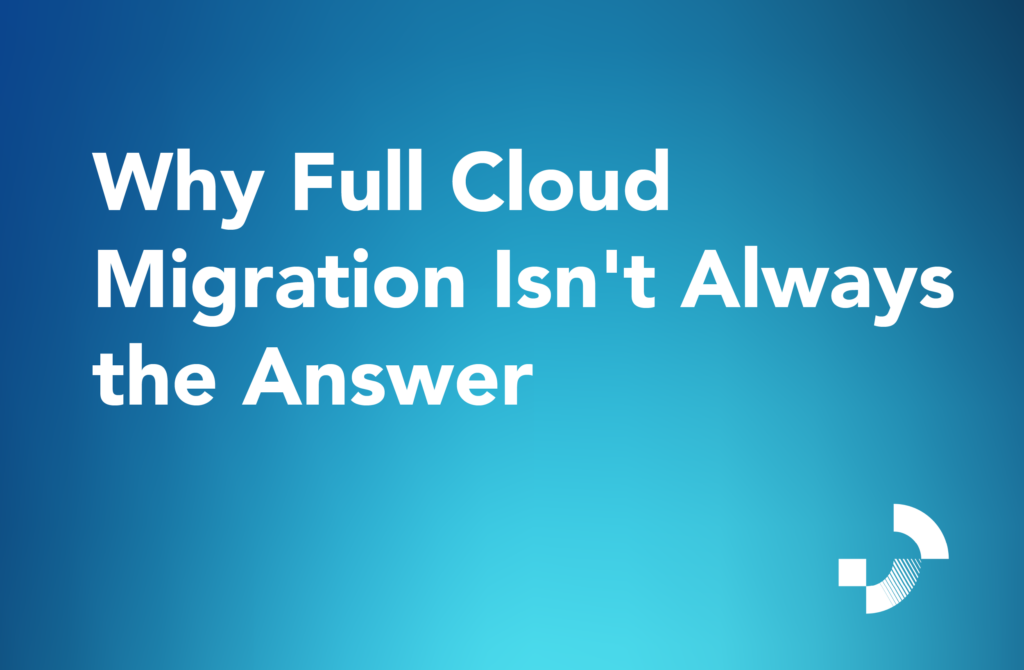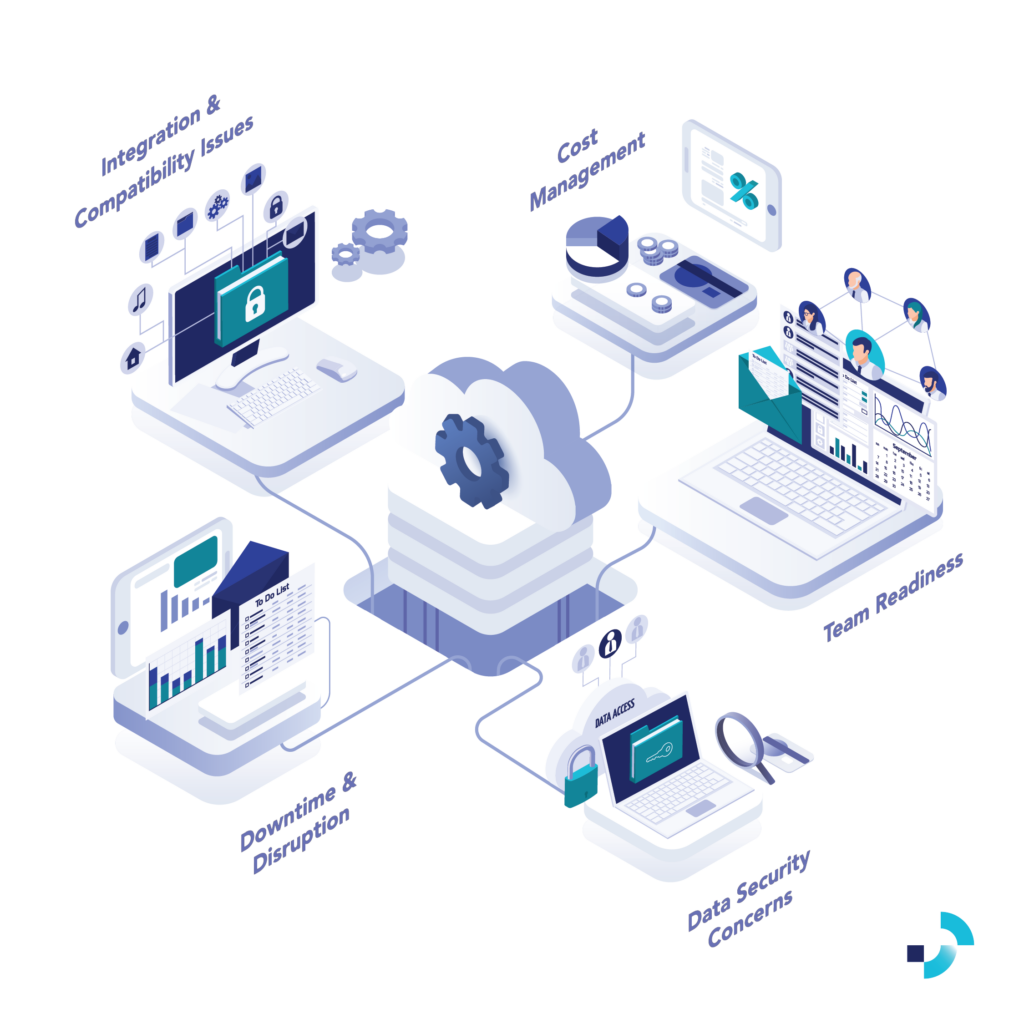Latest News
Latest News
- All
- Cloud Enablement
- Data Strategy
- Managed Services
On-Premise Systems Modernisation
Why Full Cloud Migration Isn’t Always the Answer Over the last decade, the IT world has been flooded with one clear message: “Move everything to the cloud.” For some organisations, a full cloud migration makes perfect sense. But for many others, the story is more complicated. In reality, not every system, workload or organisation benefits equally from a cloud-first approach. For many, hybrid IT modernisation offers a more flexible and sustainable solution and can often be a more strategic cloud migration strategy. Whether it’s due to compliance requirements, cost concerns, operational complexity, or simply what works best for their business model, many organisations find that a hybrid strategy (a mix of on-premise and cloud) is a smarter, more practical path forward. And they’re not alone. 58% of enterprises globally now operate hybrid IT environments, combining cloud services with critical on-premise systems. Flexera, 2024 State of the Cloud report Modernisation isn’t about abandoning what works. It’s about evolving your infrastructure to meet today’s and tomorrow’s needs, smartly and securely. Why Organisations Choose to Stay On-Prem (At Least Partially) Despite the growing buzz around cloud migration best practices and strategies, many organisations are choosing to retain significant parts of their infrastructure on-premise. Regulatory and Compliance Requirements Certain industries in particular finance, healthcare or government, face strict data privacy and security regulations. Hosting sensitive data off-site can create compliance headaches and legal risks that many organisations prefer to avoid. Cost Predictability and Control While cloud services offer flexibility, they can also introduce unexpected costs, such as fluctuating usage charges, licensing fees, and expensive data egress rates. On-premise environments, by contrast, provide predictable capital expenditure models and allow businesses to maximise the value of existing assets over time. Performance and Latency Requirements Certain applications such as real-time analytics platforms, manufacturing control systems, or high-frequency trading setups require ultra-low latency and guaranteed performance. Running these workloads on-prem often delivers better reliability and responsiveness. Existing Investments and Complexity Organisations with complex legacy systems or highly customised applications face major challenges in migrating everything to the cloud. Modernising and upgrading on-premise infrastructure can be more cost-effective, less disruptive, and operationally safer than a full rebuild. Partial Modernisation Challenges While hybrid environments offer the best of both worlds, partial modernisation isn’t without its challenges. Businesses often face issues like: Integration Complexity: Ensuring seamless communication between cloud and on-premise systems requires careful planning, robust APIs, and effective data synchronisation strategies. Security Gaps: Hybrid environments must maintain consistent security policies across platforms, a lack of visibility or weak points can expose vulnerabilities. Resource Constraints: Managing two environments can strain internal IT teams, especially when legacy systems require specialised knowledge that is becoming rarer. Operational Silos: Disparate cloud and on-prem management tools can lead to operational inefficiencies, duplicated efforts, and slower incident response times. Without the right support, hybrid IT modernisation efforts can become expensive, fragmented and difficult to scale. How Managed Services Bridge the Gap This is where Managed Services step in: providing essential cloud enablement without the risk of rushing into a one-size-fits-all solution. Partnering with a Managed Services provider allows businesses to modernise their on-premise infrastructure without the risks and resource drain of going it alone. 24/7 Monitoring and Support: Proactive management detects and resolves issues before they impact operations. Security and Compliance Expertise: Continuous patching, auditing and policy enforcement ensure that on-prem systems remain compliant and protected. Optimisation for Performance: Legacy systems are tuned, upgraded and integrated with cloud components for better efficiency without unnecessary rebuilds. Scalable Modernisation Planning: Roadmaps are developed to modernise systems at the right pace, balancing business goals, cost, and risk. With the right Managed Services partner, partial modernisation can deliver real results without the chaos of a full cloud migration. Smart Modernisation, Not Blind Migration The future isn’t purely cloud or purely on-prem. Hybrid IT modernisation helps organisations build efficient and secure environments tailored to their unique needs. Modernising your on-premise systems doesn’t mean abandoning them. With the right cloud migration strategy and support, you can: Strengthen operational resilience Control costs Enhance security Lay a foundation for future innovation Smart modernisation is the path forward, not blind migration. If you’re ready to modernise without compromising what matters most, talk to us about how Park Lane Managed Services can help with your cloud enablement and infrastructure upgrades.
Optimising legacy database systems for future growth
Many organisations are still running on database systems that were never designed for the scale and speed of today’s business environment. Over time, what once worked fine begins to feel sluggish, reports take too long to load, staff complain about system delays and customer service starts to suffer. But behind the scenes, the issue is often the same: a legacy database that hasn’t evolved with the business. As data volumes grow and demand for real-time access increases, older systems begin to crack under pressure. They weren’t built for today’s pace. More than 40% of businesses report revenue losses due to downtime, complexity and outdated systems. One of our clients in the healthcare sector was relying on a mission-critical application that was taking up to 45 seconds to return basic results. The database behind it had grown to 1.2 terabytes and was stored in a single data file, with no partitioning, no archiving or no indexing strategy. Over time, as more patient records and historical data piled up, the system scaled vertically but not strategically. Queries scanned massive tables, the transaction logs competed for disk access and performance kept degrading. The turning point came when the issues started affecting patient response times. Staff had to wait, patients had to wait and the business could no longer ignore it. The Solution? Starting by analysing query patterns and optimising indexes to better reflect real usage. Removing redundant indexes and rebuilding fragmented ones. Historical data older than two years was archived into a separate read-only database, reducing the size of active tables and dramatically improving performance. Splitting single data files into multiple files to reduce input/output contention and moving the transaction logs to a separate high-speed drive. Finally, working with the application team to introduce date-based table partitioning so queries only had to scan what was relevant, rather than the entire dataset. The result was immediate. Average response times dropped to under two seconds. The system became fast, stable and usable again without needing to be rebuilt from scratch. More importantly, the business regained confidence in a tool that staff had begun to mistrust. This kind of optimisation isn’t just about improving performance. It’s about reducing risk, boosting productivity, and extending the value of your existing systems. It’s also a way to prepare for future growth without jumping into a full-scale migration prematurely. If you’re experiencing similar issues, from slow reporting to system complaints, your database might be trying to tell you something. With the right strategy, you can address these bottlenecks in a cost-effective way and align with your business goals.
The True Cost of System Downtime
System downtime can be more than just a minor inconvenience, it can have a significant financial and operational impact on your business. Whether caused by hardware failures, cyberattacks, or human error, these unexpected disruptions can lead to lost revenue, reduced productivity and damage to your brand reputation. Downtime can be costly, and the expenses go beyond immediate revenue loss. Businesses must consider: Lost Revenue When systems go down, sales transactions, customer interactions, and business operations can come to a halt. According to industry estimates, IT downtime costs businesses an average of $5,600 per minute, depending on the company size and industry. Decreased Productivity Employees rely on IT systems to perform their tasks. When systems are unavailable, workflows are disrupted, leading to wasted work hours and inefficiencies. Recovery Costs Fixing downtime-related issues often requires significant resources, including IT staff overtime, emergency hardware replacements, and software recovery efforts. Reputational Damage Customers expect seamless service. Frequent or prolonged downtime can erode trust, leading to customer churn and negative brand perception. How Managed Services Reduce Disruptions A proactive approach to IT management is the key to minimising downtime and ensuring business continuity. Managed Services provide businesses with: Preventing Security Breaches Cyber threats are a leading cause of system downtime, with ransomware, phishing attacks and malware compromising critical business operations. Managed Services providers take a proactive stance on cybersecurity by: Implementing advanced threat detection to identify and neutralise threats before they escalate. Enhancing endpoint security to protect all devices connected to the network. Conducting regular security audits and compliance checks to prevent vulnerabilities. Proactive Monitoring & Maintenance Rather than reacting to issues after they occur, Managed Services providers continuously monitor systems to detect and resolve potential problems before they cause disruptions. Faster Response & Resolution Times With round-the-clock IT support, businesses can mitigate downtime quickly, minimising operational disruptions and financial losses. Regular System Updates & Patch Management Keeping software, hardware, and security systems up to date reduces vulnerabilities and enhances overall system performance.
Overcoming Cloud Migration Challenges for a Secure Transition
Cloud migration offers immense benefits, from enhanced scalability to improved operational efficiency. However, transitioning to the cloud comes with its own set of challenges, particularly when it comes to security, integration and cost management.







